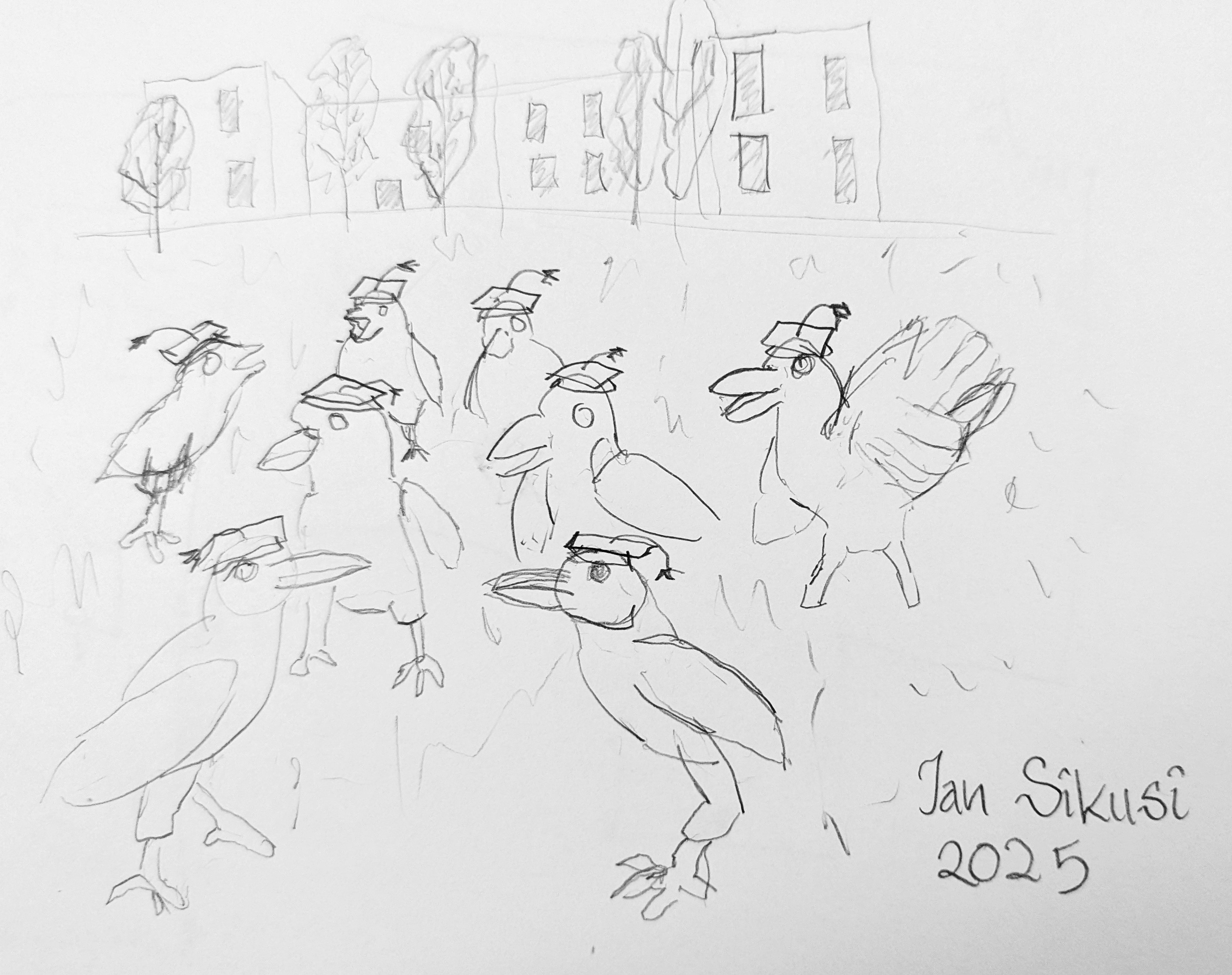The Birds Know Everything
Proceedings of the 1st Corvid Symposium on Human Studies
Unofficial transcript * 27 May 2025

Field-Observer’s Preface:
The transcript that follows records a formal scholarly gathering convened by birds, for birds: a symposium at which every speaker, chair, and note-taker was avian; predominantly crows with a smattering of allied passerines. Stationed in a camouflaged hedge and armed with a parabolic microphone, I captured the entire proceeding without human participation. Each caw, bill-click, wing-tap, and outraged coo appears verbatim; transliteration conforms to the International Cawmanscript Alphabet (ICA).
Scientific Program
- Opening Convocation & Aerie-Land Acknowledgement
- Keynote Address : Anthropogenic Environmental Modifications: Threat Matrix or Opportunity Space?
- Paper Session I: Cognitive & Ontological Studies
- Shiny Object Ontology : Dr Corvus brachyrhynchos
- Acoustic Signatures of Human Alert Calls : Prof. Corvus corone
- Paper Session II: Flight Energetics & Urban Aeroecology
- Urban Thermal Columns and Energy-Efficient Flight-Path Optimisation : Scholar-Watcher 37
- Invited Rebuttal : Assoc. Prof. Columba livia domestica (Institute for Pigeon Urban Studies)
- Resolutions & Adjournment Flight Pattern
Keynote : Professor Corvus corax
Excerpt (translated):
“Fellow corvids and allied passerines, our civilisation perches at a bifurcation point.
Humanity’s concrete forests multiply; their refuse is abundant, yet their surveillance technologies burgeon likewise.
We must interrogate intention, anticipate counter-measures, and, when prudent, exploit skylines they have so thoughtfully erected.”
Paper 1 : “Shiny Object Ontology”
Presenter: Dr Corvus brachyrhynchos (Department of Reflective Phenomena)
Abstract:
A three-factor ontological model (Radiance, Portability, Symbolic Capital) is proposed to classify anthropogenic reflectors.
Empirical data (n = 427 objects) were gathered via systematic acquisition flights across five urban micro-biomes.
- Methodology: Multimodal spectral analysis; inter-observer reliability κ = 0.88.
- Findings: Objects scoring ≥ 8 on the Radiance scale correlate with increased juvenile learning behaviours.
- Implications: Incorporating high-radiance artefacts into nest infrastructure may enhance fledgling neuroplasticity.
Q&A Highlights
Delegate from Elm 4B: “Does specular irregularity affect symbolic capital in courtship rituals?”
Dr Brachyrhynchos: “Preliminary evidence suggests a quadratic relationship; further longitudinal work required.”
Paper 2 : “Acoustic Signatures of Human Alert Calls”
Presenter: Prof. Corvus corone
Key Data Points:
- Four dominant frequency bands (0.9 – 3 kHz) recur across urban centres.
- Temporal clustering of car-alarm cycles provides reliable early-warning indicators of vehicular departure (p < 0.01).
- Human expletive forms exhibit regional dialects; mapping these improves risk assessment.
Conclusion: Incorporating human alarm acoustics into collective memory structures (TGCR) augments flock-level threat detection.
Paper 3 : “Urban Thermal Columns and Energy-Efficient Flight-Path Optimisation”
Presenter: Scholar-Watcher 37 (High-Voltage Perch Research Chair)
- Deployed 40 micro-temperature loggers on lampposts, rooftops, and mature canopies across a 6 km² urban grid.
- Generated high-resolution uplift maps showing two daily peak columns: glass-façade noon surge and asphalt dusk rebound.
- Experimental flight trials (n = 112 routes, 2 km each) recorded an average 18 % reduction in wing-beat frequency when paths aligned with mapped columns.
- Energetic-cost model predicts savings scale with the square of column velocity (R² = 0.91), suggesting substantial seasonal carry-over benefits.
Scholar-Watcher 37: “Systematic incorporation of thermal-column atlases into fledgling curricula could extend dispersal ranges by one-third without additional caloric intake.”
Invited Commentary : Associate Professor Columba livia domestica
With a brisk wing-flap of academic courtesy, the pigeon delegate presented a practical addendum titled
“Vertical Bias in Corvid Field Methods: Toward a Multi-Altitude Research Framework.”
- Methodological Concern: Current crow-led studies collect data almost exclusively from rooftops and high wires, ignoring ground-level phenomena that influence human–bird dynamics.
- Proposed Solution: A collaborative altitudinal sampling grid of pigeons monitoring sidewalks and plazas, and corvids maintaining aerial observations, to produce truly three-dimensional urban ecology models.
- Illustrative Case: Time-lapse footage showing how pedestrian foot traffic disperses midday seed spills in patterns invisible from canopy height.
Prof. Pigeon (closing remark):
“Science advances on the strength of perspective. Share the airspace; share the insight.”
Resolutions & Adjournment
The assembly ratified the following:
- Establish a standing committee on Human Technological Trajectories.
- Standardise radiance-rating calibration across bioregions.
- Convene the next symposium atop the main library cupola, leveraging its superior line-of-sight and electromagnetic ambience.
Epilogue : Observer’s Note:
Upon dispersal, delegates executed a coordinated spiral ascent (an implicit endorsement of the adopted resolutions.)
x,..*'''*..,x
Copyright Jan Sikusi 2025
